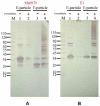Purification and characterization of enterovirus 71 viral particles produced from vero cells grown in a serum-free microcarrier bioreactor system
- PMID: 21603631
- PMCID: PMC3094384
- DOI: 10.1371/journal.pone.0020005
Purification and characterization of enterovirus 71 viral particles produced from vero cells grown in a serum-free microcarrier bioreactor system
Abstract
Background: Enterovirus 71 (EV71) infections manifest most commonly as a childhood exanthema known as hand-foot-and-mouth disease (HFMD) and can cause neurological disease during acute infection.
Principal finding: In this study, we describe the production, purification and characterization of EV71 virus produced from Vero cells grown in a five-liter serum-free bioreactor system containing 5 g/L Cytodex 1 microcarrier. The viral titer was >10(6) TCID(50)/mL by 6 days post infection when a MOI of 10(-5) was used at the initial infection. Two EV71 virus fractions were separated and detected when the harvested EV71 virus concentrate was purified by sucrose gradient zonal ultracentrifugation. The EV71 viral particles detected in the 24-28% sucrose fractions had an icosahedral structure 30-31 nm in diameter and had low viral infectivity and RNA content. Three major viral proteins (VP0, VP1 and VP3) were observed by SDS-PAGE. The EV71 viral particles detected in the fractions containing 35-38% sucrose were 33-35 nm in size, had high viral infectivity and RNA content, and were composed of four viral proteins (VP1, VP2, VP3 and VP4), as shown by SDS-PAGE analyses. The two virus fractions were formalin-inactivated and induced high virus neutralizing antibody responses in mouse immunogenicity studies. Both mouse antisera recognized the immunodominant linear neutralization epitope of VP1 (residues 211-225).
Conclusion: These results provide important information for cell-based EV71 vaccine development, particularly for the preparation of working standards for viral antigen quantification.
Conflict of interest statement
Figures





Similar articles
-
Immunological and biochemical characterization of coxsackie virus A16 viral particles.PLoS One. 2012;7(11):e49973. doi: 10.1371/journal.pone.0049973. Epub 2012 Nov 30. PLoS One. 2012. PMID: 23226233 Free PMC article.
-
Identification and characterization of a cross-neutralization epitope of Enterovirus 71.Vaccine. 2011 Jun 10;29(26):4362-72. doi: 10.1016/j.vaccine.2011.04.010. Epub 2011 Apr 16. Vaccine. 2011. PMID: 21501643
-
Pilot scale production of highly efficacious and stable enterovirus 71 vaccine candidates.PLoS One. 2012;7(4):e34834. doi: 10.1371/journal.pone.0034834. Epub 2012 Apr 17. PLoS One. 2012. PMID: 22529942 Free PMC article.
-
Production of EV71 vaccine candidates.Hum Vaccin Immunother. 2012 Dec 1;8(12):1775-83. doi: 10.4161/hv.21739. Epub 2012 Sep 19. Hum Vaccin Immunother. 2012. PMID: 22992566 Free PMC article. Review.
-
Enterovirus 71 vaccine: close but still far.Int J Infect Dis. 2010 Sep;14(9):e739-43. doi: 10.1016/j.ijid.2009.12.002. Epub 2010 Apr 18. Int J Infect Dis. 2010. PMID: 20400350 Free PMC article. Review.
Cited by
-
Structures of the procapsid and mature virion of enterovirus 71 strain 1095.J Virol. 2013 Jul;87(13):7637-45. doi: 10.1128/JVI.03519-12. Epub 2013 May 1. J Virol. 2013. PMID: 23637404 Free PMC article.
-
Progress on the research and development of inactivated EV71 whole-virus vaccines.Hum Vaccin Immunother. 2013 Aug;9(8):1701-5. doi: 10.4161/hv.24949. Epub 2013 Jun 6. Hum Vaccin Immunother. 2013. PMID: 23744508 Free PMC article. Review.
-
Development and evaluation of a pseudovirus-luciferase assay for rapid and quantitative detection of neutralizing antibodies against enterovirus 71.PLoS One. 2013 Jun 5;8(6):e64116. doi: 10.1371/journal.pone.0064116. Print 2013. PLoS One. 2013. PMID: 23755115 Free PMC article.
-
The enterovirus 71 procapsid binds neutralizing antibodies and rescues virus infection in vitro.J Virol. 2015 Feb;89(3):1900-8. doi: 10.1128/JVI.03098-14. Epub 2014 Nov 26. J Virol. 2015. PMID: 25428877 Free PMC article.
-
Beta-Propiolactone Inactivation of Coxsackievirus A16 Induces Structural Alteration and Surface Modification of Viral Capsids.J Virol. 2017 Mar 29;91(8):e00038-17. doi: 10.1128/JVI.00038-17. Print 2017 Apr 15. J Virol. 2017. PMID: 28148783 Free PMC article.
References
-
- McMinn PC. An overview of the evolution of enterovirus 71 and its clinical and public health significance. FEMS Microbiol Rev. 2002;26:91–107. - PubMed
-
- Schmidt NJ, Lennette EH, Ho HH. An apparently new enterovirus isolated from patients with disease of the central nervous system. J Infect Dis. 1974;129:304–9. - PubMed
-
- Ho M, Chen ER, Hsu KH, Wu SJT, Chen KT, et al. The Taiwan Enterovirus Epidemic Working Group. An epidemic of enterovirus 71 infection in Taiwan. N Engl J Med. 1999;341:929–935. - PubMed
-
- Lin KH, Hwang KP, Ke GM, Wang CF, Ke LY, et al. Evolution of EV71 genogroup in Taiwan from 1998 to 2005: an emerging of subgenogroup C4 of EV71. J Med Virol. 2006;78:254–262. - PubMed
Publication types
MeSH terms
Substances
LinkOut - more resources
Full Text Sources
Other Literature Sources

